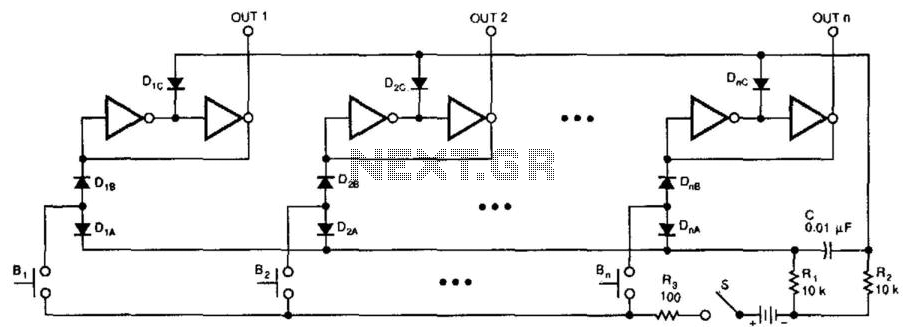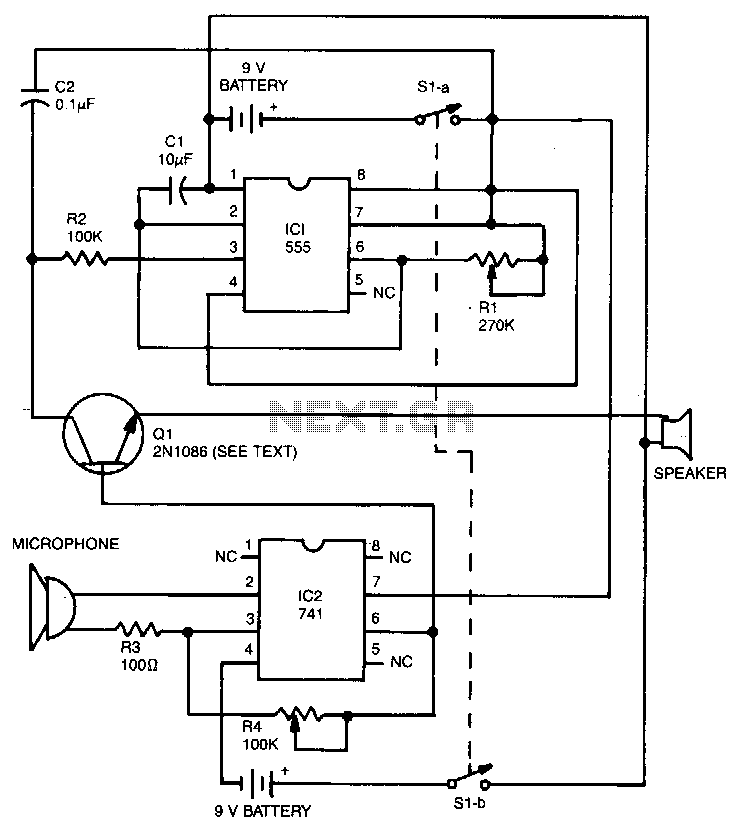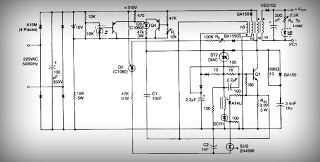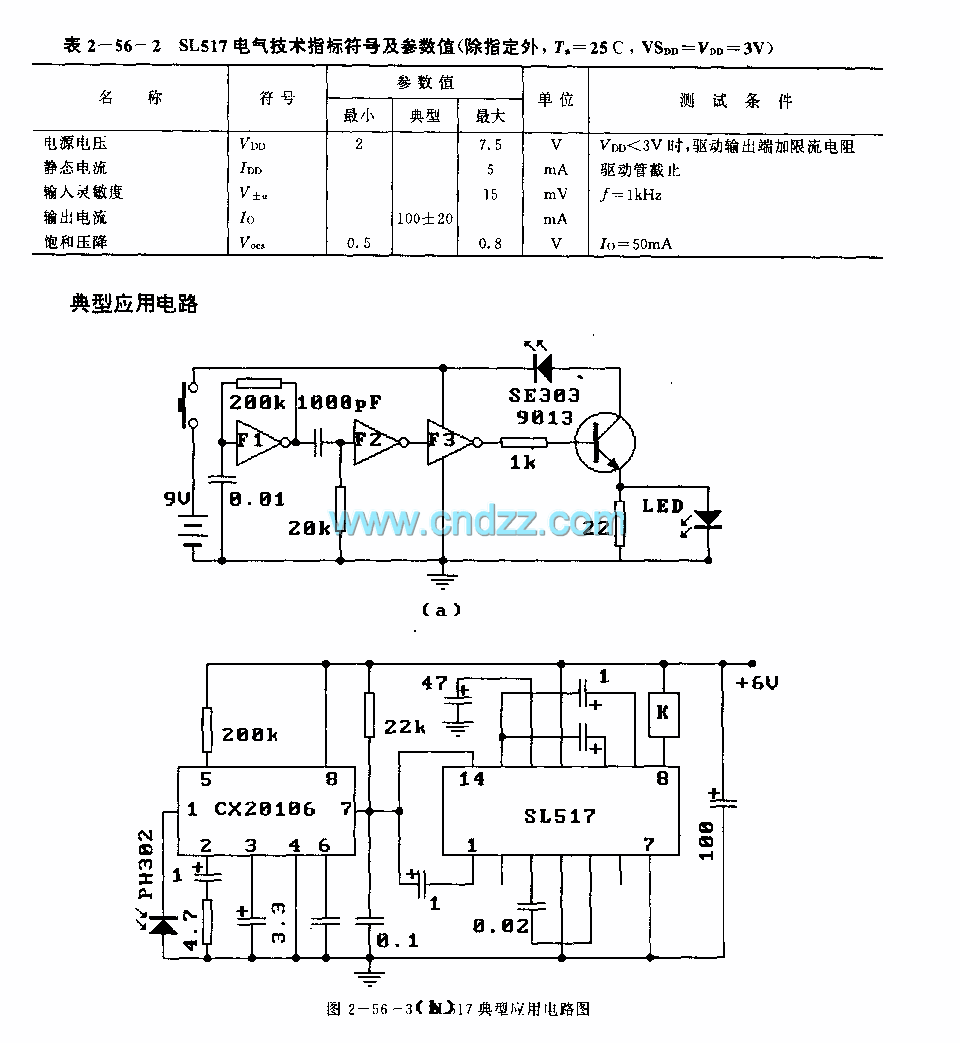
Electronic switching preamplifier
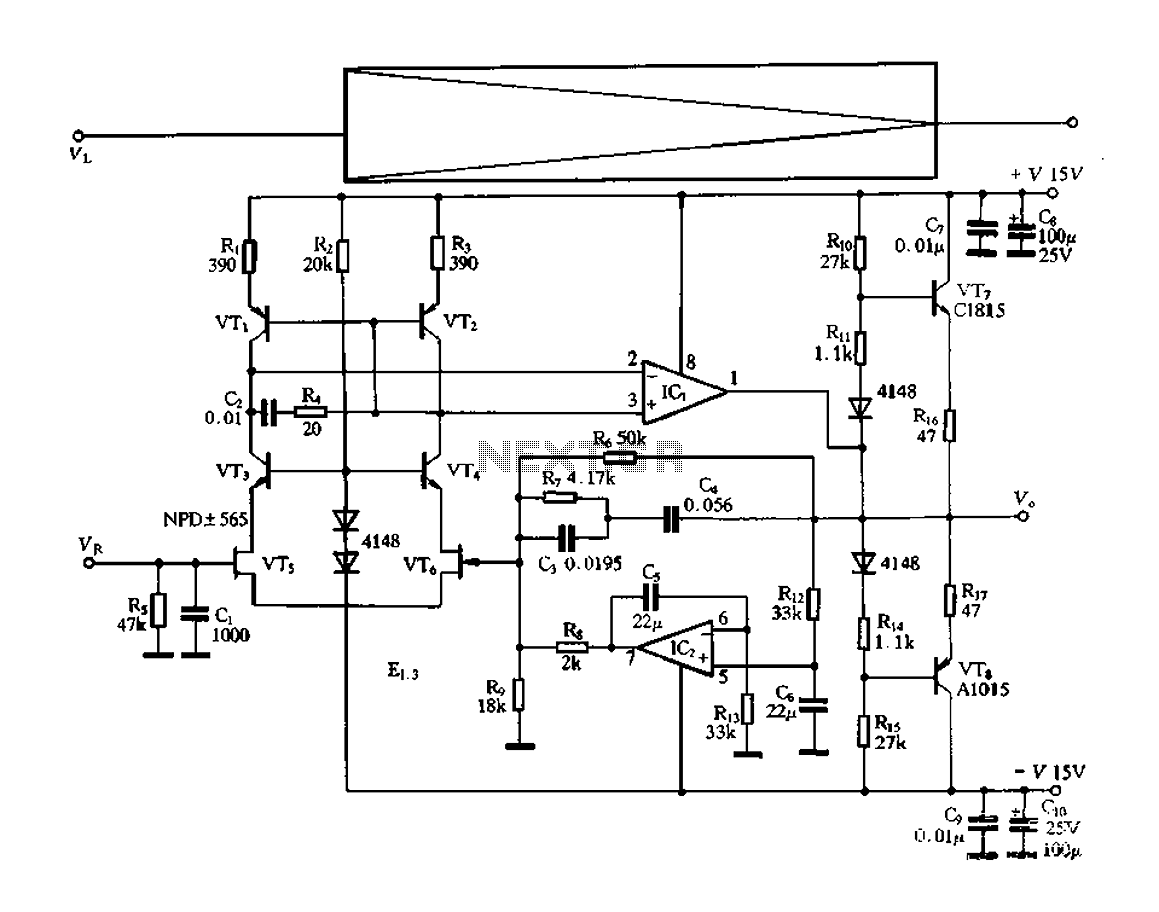
The electronic switch functions as a multifunctional preamplifier. It features a five-way touch electronic switch, a high-speed DC servo RIAA ultralow distortion amplifier, and can control volume, tone, and power amplifier electrical path phase. The TC9152, shown in Figure 3-24, includes an electronic touch switch composed of Rd. Figure 3-23 illustrates the VT3 expansion braid, which forms a common source - common emitter type differential input circuit. The transistors VTc and VT2 serve as a constant current source load. IC1 acts as the main amplifier, while Vr7 and VT8 create a push-pull output, and IC2 comprises the DC servo circuit. The components Island, C6, Rl2, and R13 define the DC servo time constant. The phono equalizer network is constructed from resistors R, R, C3, and C4, with R9 providing the DC feedback circuit path for DC gain adjustment. The differential input FET utilizes the US-manufactured NPD5565 FET, known for its low noise and high transconductance, with a withstand voltage of 55V and a current rating of 10 to 30mA. The audio switch employs Toshiba's dedicated touch electronic audio analog switches, which are designed to mitigate noise and contact issues associated with mechanical switches. The TC9152 operates under a single or dual power configuration, with an operating voltage range of 7.5 to 30V. Pins 2 and 4 connect to the positive and negative power supply, while pins 6 to 10 correspond to the first through fifth L channel input switches, and pins 18 to 14 correspond to the first through fifth R channel input switches. Pins 11 and 13 serve as the L and R channel output terminals, and pins 23 to 19 control the first to fifth switch sets, which correspond to various input sources: tuner, CD player, tape recorder, auxiliary input, and record player. When one input is activated, the corresponding L and R channel switches are turned on while the other four are turned off, with the output pin high to drive an LED display indicating the working status. The circuit has a strong drive capability, with an output current of up to 20mA. Pin 2 disables the function, bringing the level to zero and deactivating the switch control. Pins 19 to 23 connect through the positive power supply under normal conditions. Pin 3, along with external resistors Rx and capacitors Cx, determines the clock frequency of the oscillator, calculated using the formula fosc = 1/(1.5 * Rx * Cx), typically set between 20Hz and 100Hz. The oscillator begins oscillating after receiving five input clock pulses. Pin 4 serves as the analog switch control terminal, which is normally low and turns high to deactivate all analog switches. Pin 5 outputs a squelch control signal, which is high during the switching process to mute the output signal. This squelch signal is determined by the oscillator's timing, with T equal to 1/f (4 seconds). Additionally, pins 23 to 19 facilitate a remote control trigger signal conversion circuit, enabling remote operation of the system.
The electronic switch circuit is designed to provide seamless integration of various audio sources while maintaining high fidelity and low distortion. The use of a five-way touch electronic switch allows for intuitive operation and reduces the wear and tear associated with traditional mechanical switches. The high-speed DC servo RIAA amplifier ensures that audio signals are amplified accurately, preserving the integrity of the sound.
The differential input circuit configuration, utilizing common source and common emitter arrangements, enhances the circuit's performance by minimizing noise and maximizing gain. The choice of the NPD5565 FET is particularly significant, given its low noise characteristics and high transconductance, which contribute to the overall audio quality.
The flexibility of the TC9152 allows it to operate across a wide voltage range, making it suitable for various applications. The inclusion of a DC servo circuit further enhances the stability of the amplifier, ensuring consistent performance over time. The phono equalizer network is critical for adapting the audio signals from different sources, ensuring that the output remains balanced and true to the original recordings.
In summary, the electronic switch and preamplifier design provides a robust solution for audio signal management, combining advanced electronic components and thoughtful engineering to deliver high-quality audio performance in a versatile package.Electronic switch is a multifunctional preamplifier. It consists of five-way touch electronic switch, high-speed DC servo RIAA ultralow distortion amplifier. It can be volume, tone control circuit and power amp electrical path phase. Figure 3-24 is the TC9152. Composed Rd electronic touch switch. In Figure 3-23 VT3 ~ expansion upbraid composition common source - common emitter type differential input circuit, VTc, VT2 is mirroring the constant current source load. IC1 main amplifier, Vr7, VT8 push-pull output o IC2 composition DC servo circuit, Island, C6, Rl2, R13 DC servo time constant can be determined.
R, R, C3, C4 composition phono equalizer network., R9 DC feedback circuit path for DC gain adjustment. Circuit, the differential input FET to US production NPD5565 FET on the tube, is a low-noise high transconductance only on the tube, a withstand voltage of 55v-j aim is 10 ~ 30rnAr parameters can also be used, similar to the characteristics of a field effect should tube.
Audio switch uses Toshibas dedicated touch electronic audio analog switches (non-energy than conventional digital switches intended), to eliminate the impact of noise and poor contact phenomena arising from mechanical switch. 152 can be single, dual power under normal operation, the operating voltage range of 7.5 ~ 30V0 2412 feet respectively connected to the positive and negative power; 6 to 10 feet for the first L channel input to the fifth child switches; 18 ~ 14 feet for the first through fifth group R channel input switch; 1113 feet respectively, L, R channel output terminal; 23 to 19 feet were the first to fifth set of switches control terminal, where respectively FUNER ( tuner), CD (CD player), tAPE (tape recorder), AUX (auxiliary input), pHONO (record player), when one is a foot-high v + trigger corresponding L, R channel switch is turned on the other four open were closed off, while the output pin high, driving LED display working status, strong five foot drive capability, output current up to 20mA; 2 feet for the end of the function is disabled, then zero level, the switch control does not work 19 to 23 feet, through the positive power supply connected normally the case; 3 pin external Rx, Cx determines the clock frequency of the oscillation frequency by the formula fosc 1/1,5RxCr decisions generally take 20Hz ~ 100H, the oscillator starts to oscillate after entering the role, after five input clock pulse oscillator stop swing; 4 feet off the analog switch control terminal, usually then low, then high when, all of the analog switch is turned off, Lee may this pin can be more than just cut off the feet of four 152 in combination; 5 feet squelch control output, high output in the process of switching level for driving mute switch off the output signal (rate circuit is not used, so no mute function), squelch signal output by the oscillation frequency of the time table to determine: T startled feet 1/f 4 second; in addition, 23 to 19 feet with remote Control trigger signal conversion circuit also enables remote operation of the circuit .
The electronic switch circuit is designed to provide seamless integration of various audio sources while maintaining high fidelity and low distortion. The use of a five-way touch electronic switch allows for intuitive operation and reduces the wear and tear associated with traditional mechanical switches. The high-speed DC servo RIAA amplifier ensures that audio signals are amplified accurately, preserving the integrity of the sound.
The differential input circuit configuration, utilizing common source and common emitter arrangements, enhances the circuit's performance by minimizing noise and maximizing gain. The choice of the NPD5565 FET is particularly significant, given its low noise characteristics and high transconductance, which contribute to the overall audio quality.
The flexibility of the TC9152 allows it to operate across a wide voltage range, making it suitable for various applications. The inclusion of a DC servo circuit further enhances the stability of the amplifier, ensuring consistent performance over time. The phono equalizer network is critical for adapting the audio signals from different sources, ensuring that the output remains balanced and true to the original recordings.
In summary, the electronic switch and preamplifier design provides a robust solution for audio signal management, combining advanced electronic components and thoughtful engineering to deliver high-quality audio performance in a versatile package.Electronic switch is a multifunctional preamplifier. It consists of five-way touch electronic switch, high-speed DC servo RIAA ultralow distortion amplifier. It can be volume, tone control circuit and power amp electrical path phase. Figure 3-24 is the TC9152. Composed Rd electronic touch switch. In Figure 3-23 VT3 ~ expansion upbraid composition common source - common emitter type differential input circuit, VTc, VT2 is mirroring the constant current source load. IC1 main amplifier, Vr7, VT8 push-pull output o IC2 composition DC servo circuit, Island, C6, Rl2, R13 DC servo time constant can be determined.
R, R, C3, C4 composition phono equalizer network., R9 DC feedback circuit path for DC gain adjustment. Circuit, the differential input FET to US production NPD5565 FET on the tube, is a low-noise high transconductance only on the tube, a withstand voltage of 55v-j aim is 10 ~ 30rnAr parameters can also be used, similar to the characteristics of a field effect should tube.
Audio switch uses Toshibas dedicated touch electronic audio analog switches (non-energy than conventional digital switches intended), to eliminate the impact of noise and poor contact phenomena arising from mechanical switch. 152 can be single, dual power under normal operation, the operating voltage range of 7.5 ~ 30V0 2412 feet respectively connected to the positive and negative power; 6 to 10 feet for the first L channel input to the fifth child switches; 18 ~ 14 feet for the first through fifth group R channel input switch; 1113 feet respectively, L, R channel output terminal; 23 to 19 feet were the first to fifth set of switches control terminal, where respectively FUNER ( tuner), CD (CD player), tAPE (tape recorder), AUX (auxiliary input), pHONO (record player), when one is a foot-high v + trigger corresponding L, R channel switch is turned on the other four open were closed off, while the output pin high, driving LED display working status, strong five foot drive capability, output current up to 20mA; 2 feet for the end of the function is disabled, then zero level, the switch control does not work 19 to 23 feet, through the positive power supply connected normally the case; 3 pin external Rx, Cx determines the clock frequency of the oscillation frequency by the formula fosc 1/1,5RxCr decisions generally take 20Hz ~ 100H, the oscillator starts to oscillate after entering the role, after five input clock pulse oscillator stop swing; 4 feet off the analog switch control terminal, usually then low, then high when, all of the analog switch is turned off, Lee may this pin can be more than just cut off the feet of four 152 in combination; 5 feet squelch control output, high output in the process of switching level for driving mute switch off the output signal (rate circuit is not used, so no mute function), squelch signal output by the oscillation frequency of the time table to determine: T startled feet 1/f 4 second; in addition, 23 to 19 feet with remote Control trigger signal conversion circuit also enables remote operation of the circuit .

